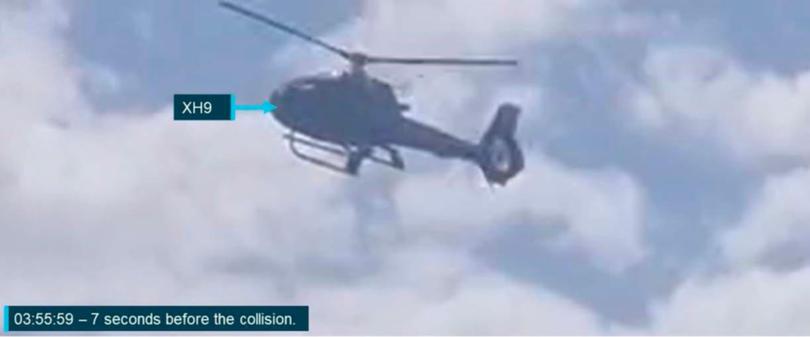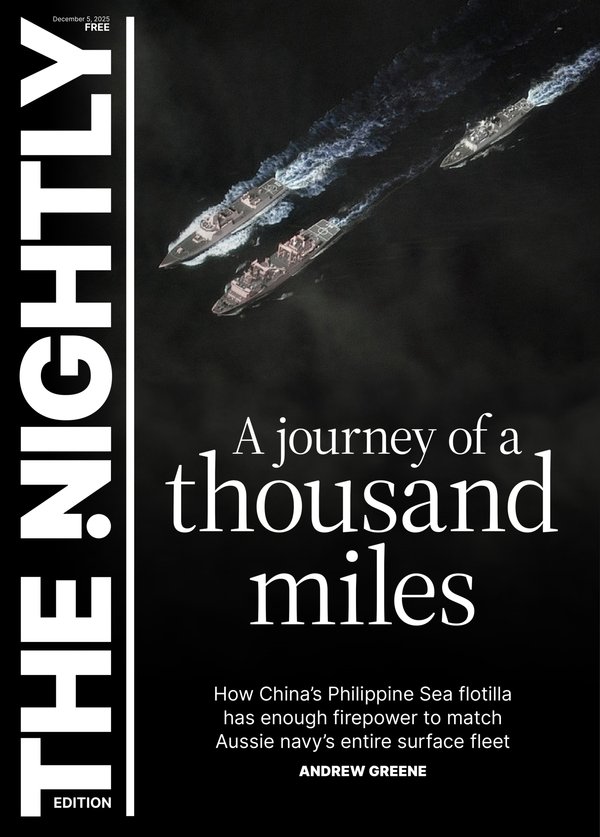Faulty radio antenna, poor pilot visibility and incorrect seatbelt use contributed to Sea World chopper deaths
A Federal investigation into one of Australia’s worst adventure tourism accidents has found a “compounding series of risk failures” — including faulty radios, poor pilot visibility and incorrect seatbelt use — contributed to a chopper tragedy which killed four people at Sea World on the Gold Coast.
The Australian Transport Safety Bureau on Wednesday published its final report into the fatal mid-air collision of two scenic flight helicopters, operating at the Queensland theme park, in January 2023.
An experienced pilot and three passengers were killed, while a second pilot and five passengers were injured, when two Eurocopters — each performing five-minute joy flights — collided near Main Beach in the tourism capital on January 2 of that year.
Sign up to The Nightly's newsletters.
Get the first look at the digital newspaper, curated daily stories and breaking headlines delivered to your inbox.
By continuing you agree to our Terms and Privacy Policy.Just before 2pm on that clear and sunny Monday afternoon, two helicopters — XKQ which was ascending and XH9 which was coming in to land — collided at a height of 130 ft.
Sea World Helicopters chief pilot Ashley Jenkinson, who had just taken off from the helipad, and three of his passengers — British newlyweds Ron and Diane Hughes and Sydney woman Vanessa Tadros — were killed in the collision.
Another three passengers — Mrs Tadros’ son, Nicholas, Victorian woman Winnie de Silva and her nine-year-old son Leon — were all seriously injured.
Watch the ATSB’s re-enactment of the crash in the video player at the top of this page.
As the two aircraft collided, the main rotor blades of XKQ passed through the cabin of incoming helicopter XH9, shattering its acrylic windscreens.
Its pilot, Michael James, and his passengers were immediately peppered with penetrating fragments.
However, Mr James safely landed his significantly-damaged aircraft on a sandbank in the Gold Coast Broadwater, which was a a pre-selected forced landing site.
The seriously injured pilot credited his sunglasses with saving his eyes from the shrapnel.

Mr James was hailed a hero for saving the lives of his five passengers but in a tragic twist of fate, a few months after the crash, he was diagnosed with cancer and passed away last year at the age of 58.
The ATSB’s final report said that pre-planning and Mr James’ positive control of the helicopter significantly reduced the consequences of the crash.
The ATSB’s 243-page final report into the fatal crash revealed a series of safety issues, made 28 findings that “highlight key lessons for operators and pilots” and issued four recommendations to Sea World Helicopters.
Among the safety issues identified, investigators found that a faulty radio antenna, poor cockpit visibility, limitations of the “see and avoid” principal and the incorrect use of seatbelts had all contributed to the crash and its fatal consequences.
“Limitations in visibility from both helicopters ... combined with competing priorities and an understanding that the airspace was clear, led to a midair collision as both helicopters were passing through the conflict point created by the positioning of the helipads,” the report said.
ATSB chief commissioner Angus Mitchell said the investigation had revealed that “a series of compounding risk failures led to a catastrophic outcome”.
Mr Mitchell said the most fundamental lesson from this investigation was that making changes to aviation operations, even those that appear to increase safety, can have unintended consequences.
The tragedy occurred just a week after Sea World Helicopters started using the two Eurocopter EC130 helicopters for its scenic flight operation. Each aircraft was operating from its own helipad 220m apart.
“In the months prior to this tragic accident, the operator had made changes to improve its tourism product, including commissioning the use of a second helipad location, known as the park pad, the introduction of the larger EC130 helicopters, and new hangar and office facilities,” he said.
“Over time, these changes undermined risk controls used to manage traffic separation and created a conflict point between launching and departing helicopters, which is where the two helicopters collided.
“The operator’s safety management system did not effectively manage the safety risk present in its aviation operation, and when numerous changes were introduced, did not implement processes to consider whether they would affect the overall safety of their flights.”

The report describes that in the lead-up to the collision, an inbound call from the incoming pilot, Mr James, failed to register with Mr Jenkinson, who was busy loading passengers on the park pad in preparation for departure.
Once passenger loading was complete, a ground crew member advised Mr Jenkinson that the airspace was clear.
“However, this advice was no longer accurate by the time the helicopter took off more than 20 seconds later, as the inbound helicopter was continuing its approach to land,” Mr Mitchell said.
“In addition, restrictions on manoeuvring at the park pad, and the angles of closure of the two helicopters, limited the visibility for the departing pilot to identify the approaching helicopter.”
Mr James, flying the inbound helicopter, had earlier sighted the departing helicopter on the park pad, but had assessed it as not being a threat, and expected to be alerted by a ‘taxiing’ radio call if that condition changed, which would then be their cue to arrange separation.
“The ATSB found faults in the radio antenna of the departing helicopter which likely prevented broadcast of the taxi call,” Mr Mitchell said.
“Without the taxiing call being received, the pilot of the inbound helicopter, who was likely focusing on their landing site, had no trigger to reassess the status of the departing helicopter as a collision risk.
“This dependency highlights that aviation operations should have multiple safety defences in place and not be vulnerable to single points of failure such as faulty radios, or a pilot’s ability to detect another helicopter in a visually constrained environment.”
A visibility study conducted by the ATSB, which cross-validated onboard flight data with footage from multiple cameras onboard and outside the helicopters, confirmed that both pilots’ view of the other helicopter was limited in the lead-up to the accident.
“This limited visibility combined with both pilots’ competing priorities and understanding the airspace was clear, led to the midair collision as both helicopters passed through the conflict point created by the introduction of a second helipad nine months earlier,” Mr Mitchell said.
“While the operator did have in place a system of radio calls, hand signals and visibility devices that was intended to alert pilots of the presence of another helicopter, the investigation found that system to have significant flaws.”
The agency’s transport safety director Stuart Godley said the Cockpit Visibility Study reinforced the known limitations of the ‘”ee-and-avoid” principle.
Mr Mitchell said occupant survivability - another key focus of the investigation - found that passengers’ seatbelts were incorrectly fitted due to the interaction of their lifejackets with their seatbelts.
“While the ATSB was unable to determine to what extent the incorrectly fitted seatbelts contributed to the passengers’ injuries, we know that correctly fitted restraints improve survivability for passengers in the event of collisions.”
The investigation report notes there is no readily available guidance, either from lifejacket manufacturers or regulatory authorities, regarding the correct fitment and use of constant wear lifejackets when occupants are using multipoint seatbelts.
Mr Mitchell said this puts occupants in helicopter tourism operations worldwide at risk of increased injury in an accident due to inadvertent incorrect use of seatbelts.
The ATSB found that another factor which “increased risk” was Mr Jenkinson’s “very likely” use of cocaine around one and a half days prior to the accident.
“While the pilot was unlikely to have been directly affected by the drug at the time of the accident, the actual effect of illicit substances and associated adulterants on safety of flight cannot be predicted by users and periods of impairment beyond the anticipated effects can occur,” the report said.
Mr Mitchell said “each individual failing was only one part” of what caused the fatal incident.
“You need to put all of them together for this outcome to have occurred, and the outcome could not have been worse,” he said.
The ATSB’s final report detailed a number of safety actions that Sea World Helicopters has implemented since the accident.
These include introducing a “pad boss”, a new ground staff position to provide pilots with traffic advisory information, displaying positional information of other aircraft (using “ADS-B in”) on a map display in its helicopters (using iPads with EFBs), new radio call protocols, fitting its helicopters with strobe lighting and applying high visibility paint on main rotor blades.
“We acknowledge the significant safety actions taken to date, however the ATSB is making four safety recommendations to Sea World Helicopters to address remaining safety issues,” Mr Mitchell said.
“These recommendations include formal consideration of the design of conflict points to identify opportunities for further risk controls or their elimination; developing objectives within its safety management system to focus on aviation safety risk; improving change management processes; and clarifying its change management procedure to capture the introduction of additional helicopters.”
A Sea World Helicopters’ spokesperson acknowledged the ATSB’s recommendations and said the “compliant and professionally managed organisation” would “respond within the allocated time frame”.
“Our company maintains robust safety systems, dedicated support staff and rigorous oversight protocols to uphold the highest standards of aviation safety,” a company statement said.
“We remain committed to consistently evolving our safety measures.”
Meanwhile, Shine Lawyers has launched civil action against Sea World Helicopters on behalf of some of the passengers.
“Shine Lawyers has filed a number of claims in the Supreme Court of Queensland on behalf of several people who were injured on board one of the helicopters, as well as others who were indelibly traumatised by what they witnessed on that day,” the firm’s national litigation specialist Roger Singh said on Wednesday.
“The claims for the passengers of the helicopter have been filed under the Civil Aviation Act, which caps damages at $925,000 per claimant.
“We will examine the findings of this report with a view to identifying other potential defendants and further damages which may be sought.
“No amount of money will give back what was taken from the victims of this crash, however we will ensure those responsible are held to account to the fullest extent.
“This was such a profoundly unnecessary loss of life.”
The date for a coronial inquest into the crash is yet to be set.

